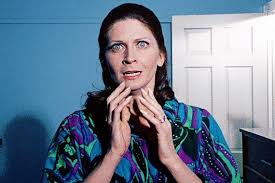What does one do after birthing a horror subgenre that would turn into a billion dollar enterprise of which you barely profit? Four years after the release of Night of the Flesh Eaters Living Dead, George Romero made the logical career move: directing a feminist allegory about witchcraft that got repurposed by its disappointed studio as softcore porn.
And you thought YOU had a bad day.
Quick Plot: Meet Joan Mitchell, a 39-year-old housewife whose daughter Nikki is about to leave home and whose husband Jack is an awful, abusive workaholic blowhard. Her living room is illuminated by very creepy children lamp statues. Life could be better.
Enter a new neighbor and rumored witch. Joan and her gal pal Shirley visit the mystery woman for a Tarot reading, wetting Joan's appetite for a dive into the supernatural. Things get even more tempting when Joan meets Gregg, Nikki's TA and casual boyfriend. Joan is both repulsed by and attracted to him, something Nikki picks up on and angrily runs away.
Left alone for a few days due to Nikki's escape and Jack's business trip, Joan heads to the nearest occult shop and stocks up on her witchcraft starter kit. First up is a spell to summon Gregg to her home, though a simple phone call seems to work without the added incense ash.
It's strange to see Season of the Witch categorized as a horror film, since it seems so clear that it's simply using some of those tenants to explore a very simple (yet very dense) subject. I'm sure many a genre fan expecting more flesh-eating witches and less loud '70s print-wearing homemakers left Season of the Witch disappointed, though probably not as much as those who rented it under the studio's slapped on original title: Hungry Wives.
Romero clearly didn't want to make a mild skin flick, nor was he diving back into the brutal well of gore he mastered with Night. While some of his dialogue feels clunky (particularly nearly 50 years later), the sentiment works. Actress Jan White doesn't feel like the most charismatic of leading ladies, but that's absolutely fitting for the character of Joan. This is a woman who's never had much of a self, and through a random combination of events, is finally coming into her own.
Sure, some of the metaphor is heavy-handed (this is the same man who made Diary of Dead, don't forget) but there's a fundamental simplicity (perhaps because of constant studio cuts to Romero's original cut) that makes the film move at the exact right pace. We only need one scene of Shirley making a fool of herself in front of young people to tell us everything we need to know about how Joan sees herself and her future. This is a woman loosely stuck in a crummy, disappointing existence. The freedom she finds in the promise of witchcraft are paired with the dangers that seem to be warning her in vivid dreams to drive her into some very big choices. It all tracks, and while the wild wallpaper certainly helps, I found it riveting.
High Points
I won't spoil it here, but know that there aren't quite enough words in a thesaurus to say just how much I adored the ending and its implications towards the entire film we'd just seen
Low Points
When you fill your frames with constant closeups of creepy Hummel-ish figurine lamps, you owe it to your audience to have them, I don't know, come alive in a nightmare sequence and terrify us all
Lessons Learned
When your daughter is balled in the next room, you handle it by kicking some ass
Take it from Ruth Gordon: if the mousse tastes chalky, don't eat it
In the early '70s, pregnancy tests were 92% accurate
Rent/Bury/Buy
By all accounts I found, Romero was never happy with Season of the Witch. It's definitely a raw film that could have benefited from a revisit, but as a remnant of its time, Season of the Witch feels like a weird hidden gem...or at the very least, stylish bit of costume jewelry that would look fabulous in a flowered mumu. It's streaming on both Amazon Prime and Shudder, and certainly worth your eyeballs.

















No comments:
Post a Comment